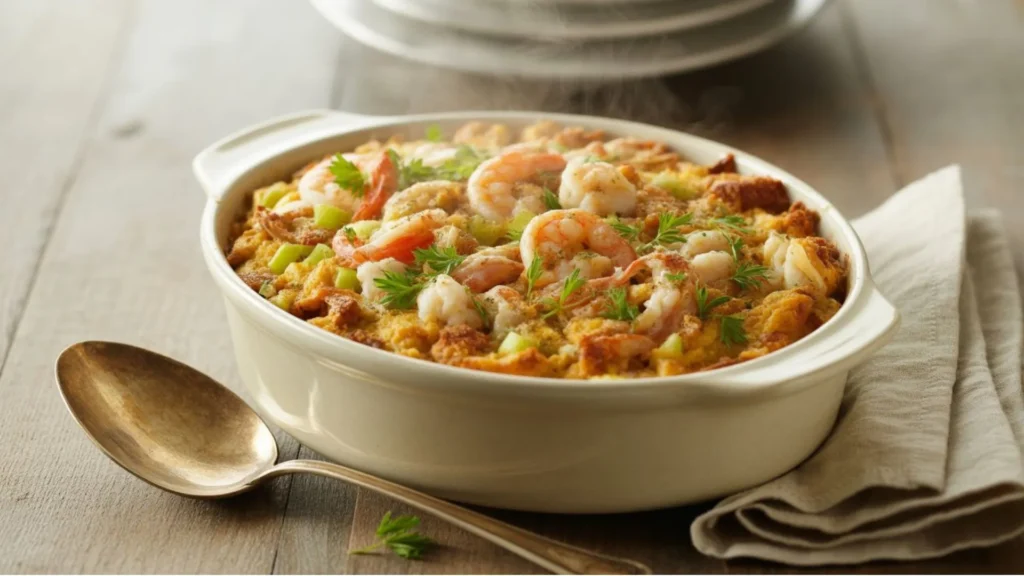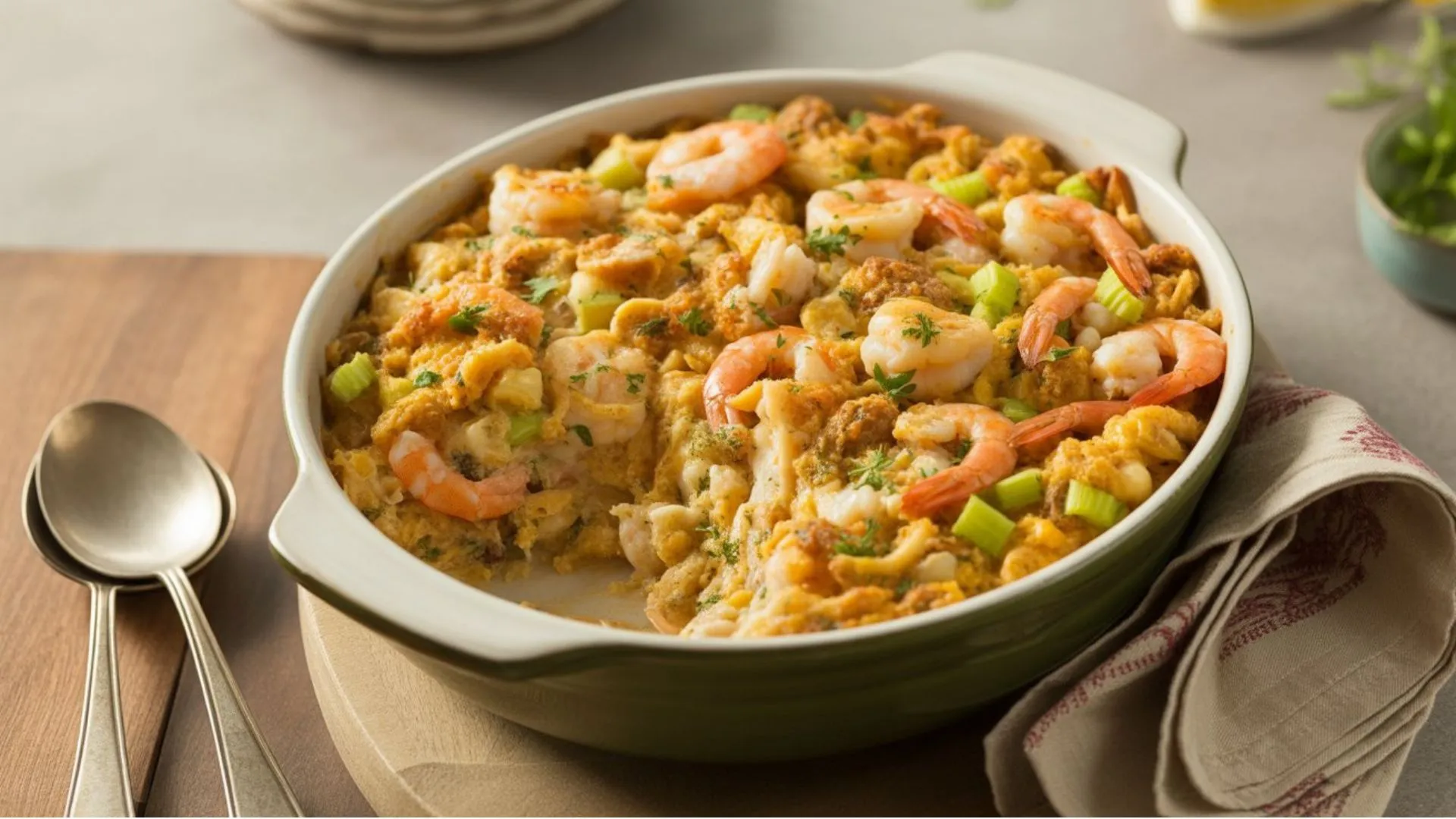Table of Contents
Seafood Dressing Recipe: 3 Secrets Professional Cooks Swear By for Restaurant-Quality Results at Home
Okay, let me tell you something – there’s this magical moment when you bite into really good seafood dressing, and it’s like your taste buds just got transported to some dreamy coastal kitchen. You know the kind I’m talking about? Where some sweet grandma has been perfecting her recipe for like, forever.
My own grandma had these weathered hands that could work magic with crabmeat, and honestly? She never measured a dang thing. Yet somehow, every single batch was absolutely perfect. It used to drive me nuts trying to figure out her secret!
So here’s the thing – you’ve probably wondered why some people can whip up seafood dressing that’ll make you want to lick the bowl clean, while others end up with something that tastes like soggy cardboard. Well, I’m about to spill the tea on the three game-changing tricks that pros use to make their seafood dressing absolutely incredible. Trust me, once you know these secrets, you’ll never make mediocre seafood dressing again!
What Makes a Perfect Seafood Dressing Recipe
Look, making amazing seafood dressing isn’t rocket science, but there’s definitely some method to the madness. It’s all about getting that sweet spot where everything just works together perfectly. If you’re looking for more inspiration, check out these amazing seafood dressing variations that’ll give you even more ideas to work with.
The Foundation of Great Seafood Dressing
Here’s what you need to nail: the right amount of moisture (not too wet, not too dry), good texture that doesn’t turn to mush, and flavors that actually complement each other instead of fighting for attention.
Your seafood needs to be fresh – and I mean really fresh. We’re talking about that “smells like the ocean on a good day” kind of fresh, not that “somebody left fish in a hot car” situation. The bread? That’s not just filler, my friend. It’s like the canvas that soaks up all those amazing flavors you’re building.
And can we talk about seasoning for a hot second? This is where most people mess up big time. You can’t just dump everything in at the end and hope it works out. Nope, seasoning happens in layers, like building a really delicious flavor lasagna.
Common Mistakes to Avoid
Here’s what drives me absolutely crazy – people who overwork their crabmeat! You’re breaking up those beautiful lumps that cost you a fortune. Stop it!
Also, using crappy bread is like building a house on a wobbly foundation. Don’t do that to yourself. And please, for the love of all that’s holy, don’t cook this thing at the wrong temperature. You’ll either end up with seafood jerky or something that’s still cold in the middle.
Secret #1 – The Holy Trinity of Seafood Selection and Preparation
Alright, here’s where things get real. Your seafood game needs to be on point, or everything else is just window dressing.
Choosing the Right Seafood Combination
So here’s my take – crab and shrimp are like the power couple of seafood dressing. The crab brings this sweet, delicate flavor that’s all sophisticated, while shrimp adds that slightly briny kick and firmer texture. They’re perfect together, like peanut butter and jelly, but way fancier.
When you’re picking out seafood, use your nose! Fresh stuff smells like a clean ocean breeze, not like… well, let’s just say you’ll know when it’s bad. Fresh crab feels heavy (that’s the good stuff), and shrimp should be firm with shells that aren’t all slimy.
Oh, and here’s a pro tip – buy your seafood when it’s in season. Your wallet will thank you, and the quality will be way better. Gulf shrimp in summer? Chef’s kiss
Professional Preparation Techniques
Here’s something that’ll blow your mind – pros are obsessed with getting rid of excess water. I’m talking pat-it-dry-then-let-it-air-dry-some-more obsessed. Why? Because water is the enemy of flavor, my friend.
And timing? Oh boy, timing is everything. Shrimp cooks crazy fast and keeps cooking even when you take it off the heat, so don’t go overboard. Crab’s usually already cooked, so you’re just warming it up and letting all those flavors get cozy together.
Keep everything cold until you’re ready to rock and roll, then work fast. Nobody wants tough, rubbery seafood. That’s just sad.
Secret #2 – The Perfect Bread Base and Moisture Balance
Okay, this is where things get a little nerdy, but stick with me because this stuff actually matters.
Bread Selection That Makes the Difference
Day-old French bread is your best friend here. Fresh bread turns into a soggy mess faster than you can say “oops,” and bread that’s too old is basically cardboard. You want that Goldilocks zone – not too fresh, not too stale, but just right.
The holes in good French bread aren’t just for looks – they’re like little flavor pockets that soak up all the good stuff. Dense bread is a no-go because it’ll turn your dressing into a brick.
Here’s what you do: cut your bread into chunks, spread them out on a baking sheet, and let them dry out in a low oven. Don’t brown them! Just get them dry enough that they won’t fall apart when you add liquid later.
Mastering Moisture Control
This is where I see people panic the most. Use warm stock, not cold – it soaks in way better and doesn’t shock your other ingredients. The ratio’s usually somewhere between 2:1 and 3:1 (stock to bread), but honestly? You gotta feel it out.
Add your liquid slowly and fold gently. I can’t stress this enough – SLOWLY and GENTLY. You’re not making scrambled eggs here. Let each bit soak in before adding more, or you’ll end up with soggy spots that nobody wants.
And keep everything at room temp when you’re mixing. Cold ingredients are stubborn and don’t want to play nice together.
Secret #3 – Layered Seasoning and Flavor Building
This is the secret sauce, literally. Well, not literally sauce, but you know what I mean.
The Professional Seasoning Approach
Here’s the thing – you can’t just throw all your spices in at the end and call it a day. That’s amateur hour! You build flavors step by step, like you’re composing a symphony or something fancy like that.
Season your veggies while they’re cooking, create that flavorful foundation, then build on it. Your spice blend should make the seafood taste more like itself, not hide it under a mountain of seasoning.
Fresh herbs are tricky little things. The hardy ones (thyme, sage) can handle the heat, but delicate ones like parsley and chives need to go in at the end so they don’t turn all sad and wilted.
Advanced Flavor Techniques
Those aromatic veggies (onions, celery, bell peppers) aren’t just there for show. Take the time to caramelize them properly – it’s like adding a layer of sweetness that makes everything else pop.
Season your seafood separately before you mix everything together. This way, every single bite tastes intentional, not like you just hoped for the best.
Keep some finishing touches handy for the end – good salt, fresh herbs, maybe a squeeze of lemon. Taste and adjust right before serving, because that’s when you can really make it sing.

3 Professional-Grade Seafood Dressing Recipes
Classic Louisiana-Style Seafood Dressing
This is the real deal, y’all – that down-home Louisiana comfort that’ll make you want to slow down and savor every bite.
Ingredients
| Ingredient | Quantity | Notes |
|---|---|---|
| Day-old French bread | 1 large loaf | Cubed and dried |
| Large shrimp | 1 lb | Peeled and deveined |
| Fresh crabmeat | 8 oz | Picked clean |
| Yellow onions | 2 medium | Finely chopped |
| Celery stalks | 3 large | Finely chopped |
| Bell pepper | 1 large | Finely chopped |
| Garlic cloves | 4 large | Minced |
| Seafood stock | 2-3 cups | Warm |
| Butter | 1/2 cup | Unsalted |
| Green onions | 1/2 cup | Chopped |
| Fresh parsley | 1/4 cup | Chopped |
| Creole seasoning | 2 tbsp | Divided |
| Bay leaves | 2 leaves | Whole |
| Hot sauce | To taste | Louisiana-style |
| Salt and pepper | To taste | Fresh ground |
Instructions
- Get your bread ready: Cut up that day-old French bread and spread it on a baking sheet. Pop it in a 200°F oven for about 15 minutes – you want it dry but not toasted.
- Build your flavor base: Melt that butter and get your holy trinity (onions, celery, bell pepper) cooking until they’re nice and soft, about 8 minutes.
- Season the stars: Toss your shrimp and crab separately with some of that Creole seasoning. Don’t be shy!
- Bring it together: Add the garlic to your veggies (smells amazing, right?), then add your seasoned seafood. Cook just until the shrimp turn pink.
- The magic moment: Fold in your dried bread, then slowly add that warm stock until everything looks happy together.
- Final touches: Throw in your herbs, bay leaves, and taste for seasoning. Adjust as needed!
- Bake it beautiful: Dump everything into a greased baking dish and bake at 350°F for 25-30 minutes until it’s golden on top.
Prep Time: 20 minutes
Cook Time: 45 minutes
Total Time: 1 hour 5 minutes
East Coast Crab and Shrimp Dressing
This one’s a bit more refined – think fancy dinner party but still totally doable for us regular folks.
Ingredients
| Ingredient | Quantity | Notes |
|---|---|---|
| Cornbread | 4 cups | Crumbled |
| White bread | 2 cups | Cubed |
| Jumbo lump crabmeat | 1 lb | Splurge on the good stuff |
| Medium shrimp | 12 oz | Chopped |
| Butter | 6 tbsp | European style if you’re feeling fancy |
| Yellow onion | 1 large | Minced |
| Celery | 2 stalks | Finely diced |
| Chicken stock | 1.5 cups | Low sodium |
| Heavy cream | 1/2 cup | Because we’re worth it |
| Fresh thyme | 2 tsp | Just the leaves |
| Fresh sage | 1 tbsp | Chopped |
| Lemon zest | 1 lemon | Fresh is best |
| White wine | 1/4 cup | Dry (save the sweet stuff for later) |
| Old Bay seasoning | 1 tbsp | The classic |
| Paprika | 1 tsp | Sweet variety |
Instructions
- Mix your bread base: Combine that cornbread and white bread in a big bowl.
- Start the magic: Sauté your onion and celery in butter until they’re translucent, then hit them with that white wine to deglaze.
- Gentle with the seafood: Fold in your crab and shrimp (be gentle with that expensive crab!), season with Old Bay and paprika.
- Bring it all together: Add your bread mixture, herbs, and lemon zest. Slowly add the stock and cream.
- Let it think about it: Give the mixture 10 minutes to absorb all those flavors.
- Bake with love: Spread in a buttered dish and bake at 375°F for 20-25 minutes until it’s set.
Prep Time: 15 minutes
Cook Time: 35 minutes
Total Time: 50 minutes
Spicy Cajun Seafood Dressing
Warning: this one’s got some serious attitude! Perfect if you like your food with a little kick.
Ingredients
| Ingredient | Quantity | Notes |
|---|---|---|
| French bread | 8 cups | Day-old, cubed |
| Crawfish tails | 8 oz | Cooked |
| Medium shrimp | 8 oz | Raw |
| Crabmeat | 4 oz | Special grade |
| Andouille sausage | 4 oz | Sliced |
| Trinity vegetables | 2 cups | The holy trinity |
| Garlic | 6 cloves | Minced |
| Seafood stock | 3 cups | Rich and flavorful |
| Cajun seasoning | 3 tbsp | Homemade is best |
| Cayenne pepper | 1 tsp | Adjust to your heat tolerance |
| Worcestershire | 2 tbsp | The good stuff |
| Green onions | 1 cup | Chopped |
| Vegetable oil | 1/4 cup | For cooking |
| Tabasco | To taste | Start small! |
Instructions
- Toast that bread: Get those cubes crispy in a 250°F oven for about 20 minutes.
- Brown the sausage: Cook that andouille until it’s nice and browned, then set it aside.
- Build the trinity: In the same pan (don’t waste those flavors!), cook your vegetables until they’re really soft, about 12 minutes.
- Spice it up: Add garlic and Cajun seasoning – your kitchen’s gonna smell incredible.
- Seafood parade: Add the shrimp first, then the crawfish and crab. Be gentle!
- The grand finale: Fold in your toasted bread and sausage, add stock slowly until it’s moist but not soggy.
- Make it sing: Add Worcestershire, green onions, and adjust the heat with cayenne and Tabasco.
- Hot and fast: Bake at 400°F for 15-20 minutes until you get that gorgeous crusty top.
Prep Time: 25 minutes
Cook Time: 40 minutes
Total Time: 1 hour 5 minutes
Pro Tips for Perfect Seafood Dressing Every Time
Essential Techniques from Professional Kitchens
Here’s some real talk from the pros – temperature control is everything. Keep stuff cold until you’re ready to combine, then work fast. Get yourself an instant-read thermometer and aim for 165°F for safety.
Timing is like conducting an orchestra. Start with the longest stuff (bread drying, stock prep) then work your way to the quick tasks. This keeps you from running around like a chicken with its head cut off.
Taste as you go! Don’t wait until the end to figure out something’s wrong. Check your seasoning, test your bread’s dryness, make sure your seafood smells right. Catch problems early!
Storage and Reheating Best Practices
If you’ve got leftovers (lucky you!), store them in shallow containers so they cool down fast. Cover tightly because nobody wants seafood that tastes like whatever else is in your fridge.
Reheating is tricky – you want to be gentle or you’ll end up with tough seafood. Add a splash of stock or cream before reheating, then warm it slowly in a covered dish. Skip the microwave if you can help it!
Want to prep ahead? You can make all the components separately, then put them together right before the final cooking. It’s a great time-saver for big meals!

Frequently Asked Questions About Seafood Dressing Recipe
Common Seafood Dressing Recipe Questions
Q: What’s the difference between seafood dressing and seafood stuffing?
A: Great question! Seafood dressing gets cooked in its own dish, while stuffing goes inside a bird. The seafood dressing recipe gives you way better control over moisture and cooking, which is why I’m team dressing all the way.
Q: Can I make seafood dressing recipe ahead of time?
A: Absolutely! You can put your whole seafood dressing recipe together up to 24 hours early. Just cover it tight, stick it in the fridge, and add about 10-15 minutes to the cooking time since it’s starting cold.
Q: What’s the best seafood combination for a seafood dressing recipe?
A: Most people swear by equal parts crab and shrimp for their seafood dressing recipe. It’s like the perfect marriage of flavors and textures – can’t go wrong!
Q: How do I prevent my seafood dressing recipe from becoming soggy?
A: The secret to a non-soggy seafood dressing recipe? Day-old bread, add liquid slowly, and make sure your seafood isn’t dripping wet. Moisture control is the name of the game!
Q: Can I freeze leftover seafood dressing recipe?
A: You can, but honestly? The texture gets a little weird after freezing. Your seafood dressing recipe is best enjoyed within 3 days of making it. Trust me on this one!
Conclusion
Look, mastering a killer seafood dressing recipe isn’t about following some rigid rules – it’s about understanding these three basic secrets that good cooks have been using forever. Get your seafood selection and prep down pat, nail that bread and moisture situation, and build those flavors like you’re creating a masterpiece.
The best part? Once you get these techniques down, you can totally make this seafood dressing recipe your own. Want it spicier? Go for it! Prefer different seafood? Switch it up! Your family’s gonna be begging you for this seafood dressing recipe for years to come.
Ready to blow some minds in the kitchen? Pick one of these recipes and give it a shot this weekend! I’d love to hear how it turns out – drop a comment below and let me know which one you tried. Bonus points if you share pics because we all know good food deserves to be shown off!
Want to explore even more seafood recipe ideas? Don’t miss these incredible seafood recipes that’ll inspire your next coastal cooking adventure!
Have You Given This Recipe A Try?
There are no reviews yet. Be the first one to write one.

